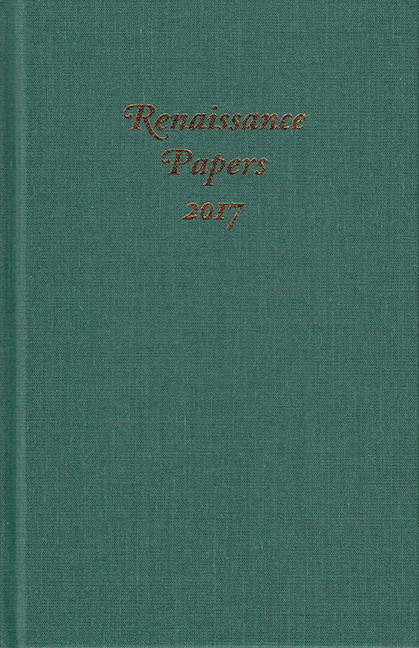Book contents
- Frontmatter
- Contents
- Dedication
- The Contested Pliability of Sacred Space in St. Paul's Cathedral and Paul's Churchyard in Early Modern London
- Classicism from Urbino: The Bichi Chapel Frescoes by Francesco di Giorgio Martini
- Visualizing the Paragone in Francisco de Zurbarán's Crucifixion with a Painter
- A Change in the Making: Shakespeare's Ovidian Sleep of Death and Display
- Old Black Rams and Mortal Engines: Transhumanist Discourse in Othello
- Dying with Speed and Felicity: Humor and Death in Book 3 of the Faerie Queene
- “If Devils Will Obey Thy Hest”: Devils in Dr. Faustus and The French Historie
- Rewriting Lucrece: Intertextuality and the Tale of Lucrece
- Economy and “Honesty” in Thomas Middleton's A Chaste Maid in Cheapside
- Glossing Authorship: Printed Marginalia in Aemilia Lanyer's Salve Deus Rex Judaeorum
- Botany and the Maternal Body in Titus Andronicus
- Unhorsing the Lustiest Challenger: Reflections on Chivalry in Richard II and Henry IV, Part 1
Glossing Authorship: Printed Marginalia in Aemilia Lanyer's Salve Deus Rex Judaeorum
Published online by Cambridge University Press: 04 April 2019
- Frontmatter
- Contents
- Dedication
- The Contested Pliability of Sacred Space in St. Paul's Cathedral and Paul's Churchyard in Early Modern London
- Classicism from Urbino: The Bichi Chapel Frescoes by Francesco di Giorgio Martini
- Visualizing the Paragone in Francisco de Zurbarán's Crucifixion with a Painter
- A Change in the Making: Shakespeare's Ovidian Sleep of Death and Display
- Old Black Rams and Mortal Engines: Transhumanist Discourse in Othello
- Dying with Speed and Felicity: Humor and Death in Book 3 of the Faerie Queene
- “If Devils Will Obey Thy Hest”: Devils in Dr. Faustus and The French Historie
- Rewriting Lucrece: Intertextuality and the Tale of Lucrece
- Economy and “Honesty” in Thomas Middleton's A Chaste Maid in Cheapside
- Glossing Authorship: Printed Marginalia in Aemilia Lanyer's Salve Deus Rex Judaeorum
- Botany and the Maternal Body in Titus Andronicus
- Unhorsing the Lustiest Challenger: Reflections on Chivalry in Richard II and Henry IV, Part 1
Summary
WHILE the presence of printed marginalia as a navigational aid in early devotional texts is almost ubiquitous, an initial scan of the printed margins of Aemelia Lanyer's Salve Deus Rex Judaeorum (1611) does not seem to offer much with which to engage. The entire volume in its most complete version contains eleven dedicatory pieces, the title poem of 1840 lines which is a retelling of Christ's passion, the country house poem “The Description of Cooke-ham,” and a final note “To the doubtful reader.” Only twenty-nine brief notes are printed in the margins. If, as William Slights has argued, “To move through the margins was to read in the fast lane,” Lanyer's margins seem designed for speed. Most scholars of Lanyer's work have passed by or elided the marginal notes, subordinating them to a separate argument. Even the most recent scholarly edition of the text preserves the marginal notes but sometimes alters their line breaks, shifting how they line up with the main text. This article slows down to consider the text's selective printed annotation within both the period's literary contexts and the networks of the volume's production. It should be said at the start that we cannot be entirely sure that every annotation is authorial, even though I will use textual clues to claim greater and lesser degrees of certainty. In general, I follow other theorists of printed marginalia in attending to the notes’ “concatenation of voices” within a printed text whose terms of production are inherently collaborative. The notes in the text's margins have much to contribute to how the volume represents its relationship to a community of female readers and writers, and the ways the earliest women authors and their printers and publishers harnessed the affordances of print to shape their work. The text's marginal notations are also strategic, expanding the range of Lanyer's literary expertise and references. The notes complicate the poems’ generic claims and finally act as through lines, connecting dedicatory material to the title poem and reinforcing both the collection's literary and devotional engagements.
One may ask if the printed marginalia in Lanyer's text is not just biblical cross-referencing? This question invokes a valid observation of printed glosses: “most early modern marginalia threaten to disappear in their own banality.”
- Type
- Chapter
- Information
- Renaissance Papers 2017 , pp. 125 - 138Publisher: Boydell & BrewerPrint publication year: 2018

